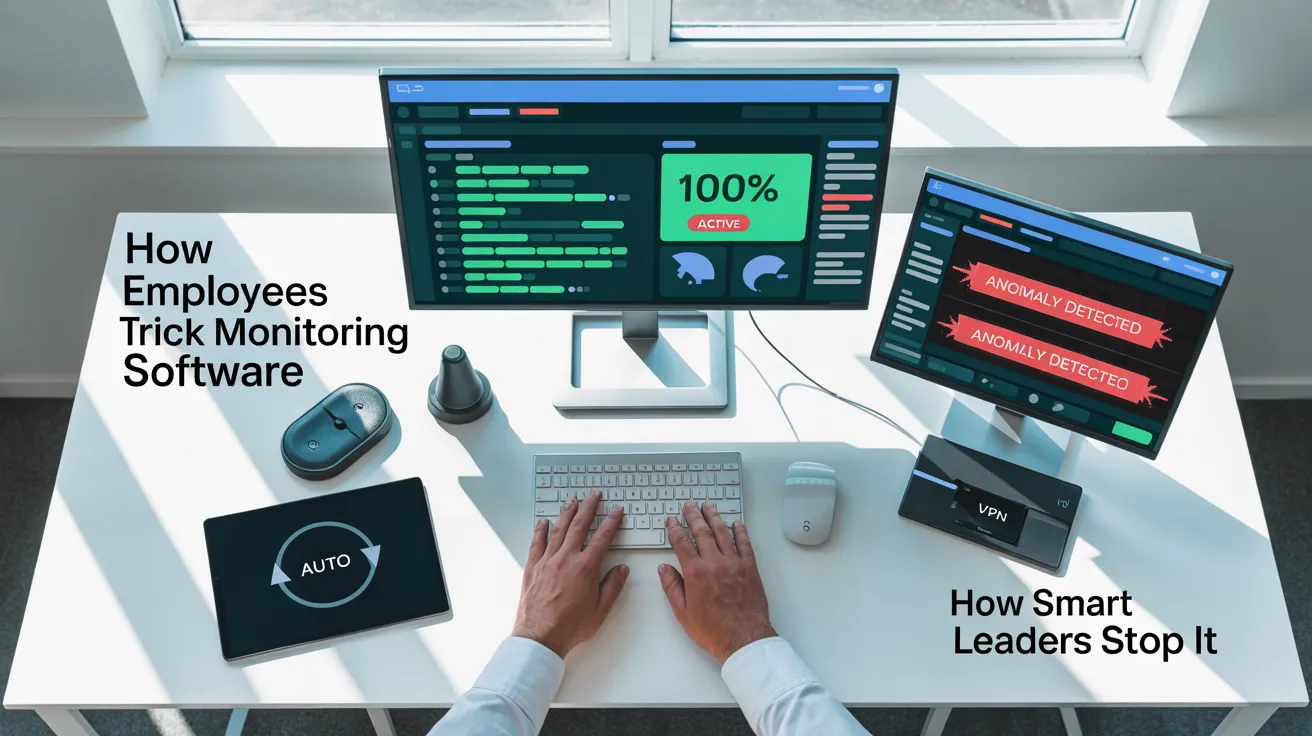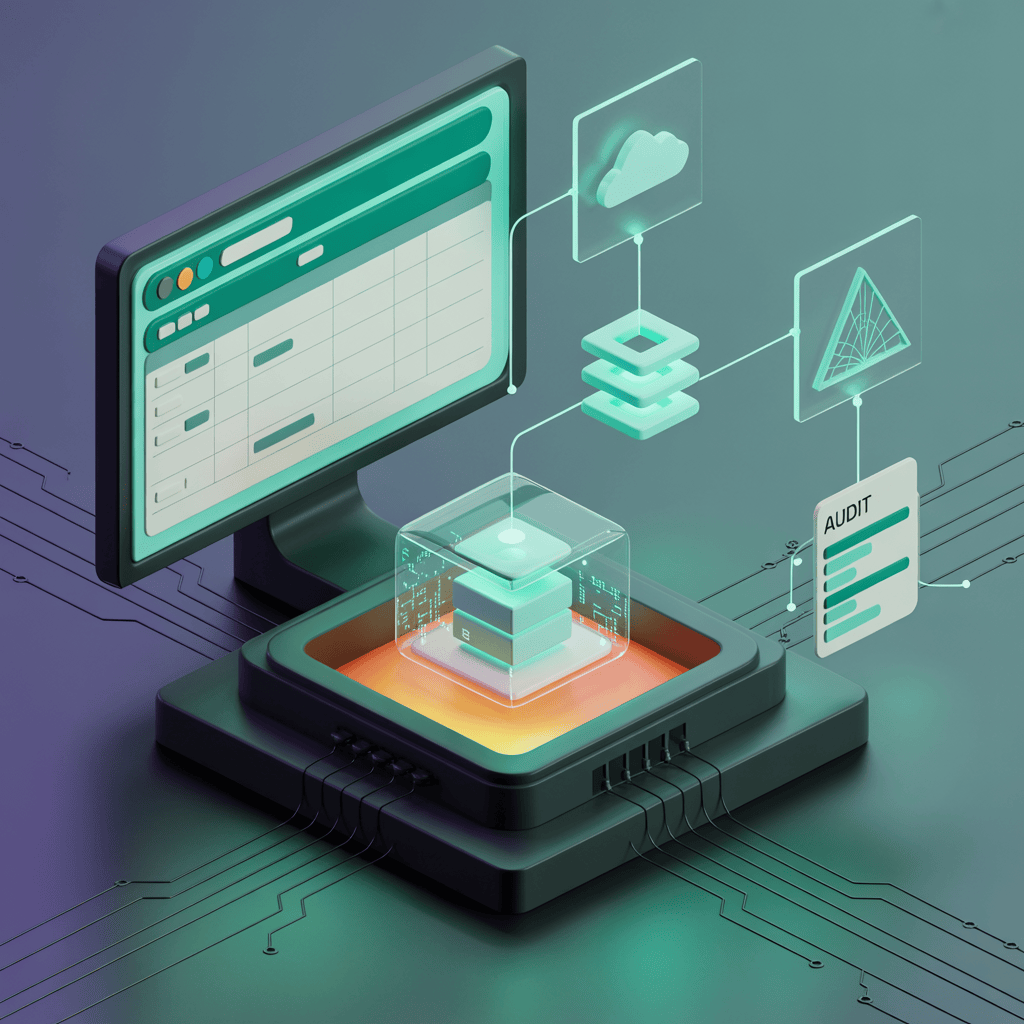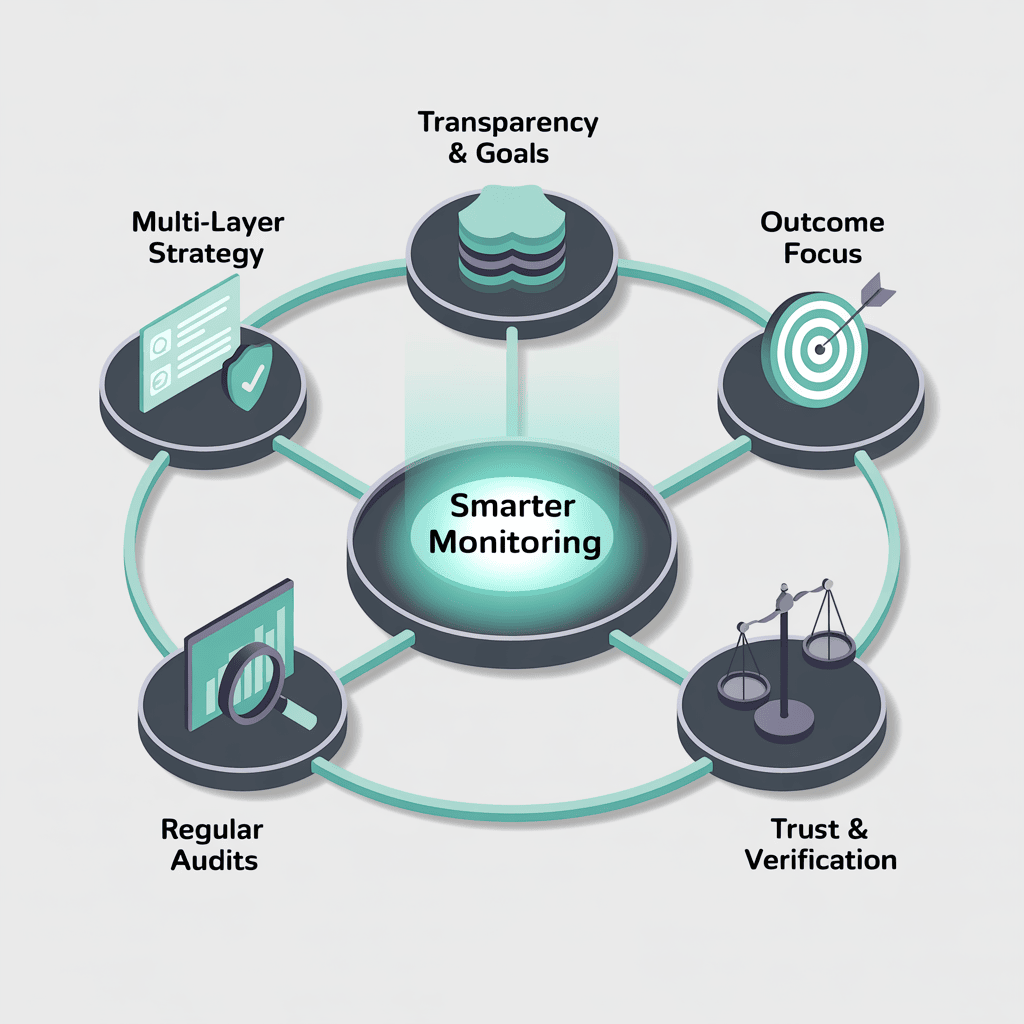How Employees Trick Monitoring Software and How Smart Leaders Stop It

Key Takeaways
-
Employees have developed clever methods to outsmart employee monitoring systems, from mouse jigglers and virtual machines to hiding behind idle windows and beyond.
-
Many of these tricks stem from trust issues, culture gaps, or flawed productivity definitions rather than pure laziness.
-
The most effective defence uses a combination of behavioural analytics, transparent tool use, and outcome-based tracking rather than pure presence tracking.
-
With the right approach, monitoring tools become trust-enhancing rather than morale-draining.
Work from anywhere seems cool until you realise your employees are not working at all!
Yes, that’s a reality for many businesses, as technology has made both employee monitoring and faking easy.
There are multiple motivations for workers to cheat monitoring software, especially when daily tracking is used against them, rather than for them.
In this blog, we’ll explore why and how employees do that and how you can stop it from happening!
In this article
- Why do employees cheat on monitoring software?
- Common tricks workers use to look good on monitoring data
- Stop monitoring software manipulation
Why Do Employees Trick Monitoring Software?
First of all, you need to understand why the employees choose the path of trickery. Understanding the reasons helps you build a stronger prevention strategy.

- Trust Issues & Culture Breakdown: Constant surveillance often backfires, where employees start to look at it as a control system, rather than a productivity enhancer.
- Other Commitments & Unclear Rules: With remote access, unbound freedom, the boundary between home and work becomes blurred. When there are no specific rules, employees get misguided.
- 100% Presence Vs Actual Output: Many organisations still value active time, like mouse movements or screen-time presence, rather than results. That encourages trickery, to be more present but unproductive.
- Peaceful Procrastination: When there’s always freedom to do it tomorrow, why would an employee rush to meet a deadline?
- Engagement Issues: If productivity monitoring software becomes disciplinary and unsupportive, engaged remote workers may become unproductive. So the least engaged workers often decide to hide behind the system.
Apart from these, misinformation or misunderstanding of the actual usage can be a reason too. However, the reasons don’t necessarily justify using illegal or unethical means to cheat someone, especially your employer!
Use a supportive employee monitoring software
The Creative Tricks: 9 Ways Employees Outsmart Monitoring Tools
I can truly understand how disappointing it is to see your employees using trickery to fool you. But not gonna lie, some tricks are so out of the blue that you will feel shocked!
Below are the most common and emerging ways employees cheat time tracking software and simple ways to spot them:
1. The Classic Illusion of Mouse & Keyboard
Both the mouse and keyboard can be items of trickery. Using a USB jiggle device or software, employees can make the mouse movements continuous. The mouse pointer will move slightly and make the remote monitoring software believe the work is going strong.
A very similar approach can be used by keyboard macros. Using software or a physical toy-like device, your employee can make the keystrokes run for infinity!
However, these tricks only work for those monitoring tools that count mouse movements or keystrokes as activity.
How to spot
If your current software can’t differentiate between actual activity with fake ones, look through productivity stats. If an employee’s activity tracking shows 100% productivity for a week without any results, then you know there’s trickery.
Also, you can choose a software that has app activity tracking or takes screenshots and records the screen. A very simple countermeasure that won’t require your manual verifications.
2. Dual-Monitor Setup & Hidden Windows
This is probably the most effective when it comes to making a mockery of monitoring tools. Why is it effective?
Well, your remote employee might be enjoying a football match for hours on the 2nd monitor, and your monitoring software will sit there thinking that’s a perfect employee!
Due to some monitoring tools’ capability to capture one screen, it’s tough to spot this.
How to Spot
Similar to the last one, just checking a week’s or a month’s activity should be enough to figure this out. Look for work outputs that don’t match logged active time or productivity reports.
Also, using tools that capture multi-monitor screenshots or random interval screen recordings can help.
Monitor employee screens
Monitor multi-screen setup seamlessly
3. Virtual Machines & Remote Access Workarounds
If you are not aware of virtual machines, basically, it’s a computer within a computer using software. Those who like to tinker with their PCs are the ones who are likely to use this particular trick.

One can load a gaming software in the VM and pretend to open a work spreadsheet.
How to spot
The VM trick can be a bit tricky. You will need to monitor network activity, remote access sessions, audit logs, and flag multiple IP/logins or patterns. Or, you can consult your monitoring tool customer service to find a custom solution for monitoring workers' computers.
How to Monitor employee internet usage
4. Idle Windows & Fake Active Sessions
Opening a legit project file or spreadsheet and leaving it open for hours without active engagement, because the tracker sees the application open and maybe some minimal interaction, it logs as “active work.”
Fake sessions are well-thought-out plans to deceive you. They try to be on the borderline of being caught and staying safe. By keeping a legit work file like a Word or Excel file open for hours and mindfully pretending.
Many application monitoring systems rely on whether an application is open or keystrokes happen, not whether meaningful work is done.
How to Spot
Tools like Apployee come with activity report graphs. There, you can see the actual % of activity at one glance. That’s enough to reveal the true colours.
Or, if you want to do it manually, compare logged website visits, application usage, or actual output, deliverables, and changes in project management.
How to identify fake productivity
Detect time theft and stop it immediately
5. Timesheet Falsification or Rounding of Hours
Entering more hours than actually worked, or rounding up time in manual or semi-automatic time tracking software to match expected hours.
Most companies fail to properly track the actual reporting time or clock-ins and outs. However, when there are manual timesheets, you know that employees will look for ways to bypass those.
Without integration to productivity or task metrics, simple timesheet data is hard to contest.
How to Spot
Rely solely on the monitoring software timesheets, not the manual ones. Cross-compare timesheet entries with productivity data, project management logs, and employee activity logs.
6. Disabling or Tampering with Monitoring Tools
While this is not a common scenario, if one of your employees’ monitoring tools keeps getting “crashed”, then it’s foul play. Temporarily disabling, uninstalling, or pausing the software manually and blaming it on the software.
How to Spot
Try to enable stealth mode or discrete monitoring. Or, you can deploy alerts for unexpected downtime or notify the employee to restart the tool. And check the audit logs to find evidence of tampering.
Generate tamperproof timesheets automatically
7. AI Automation: The New Frontier of Cheating
Some advanced workers may even use automation to generate pseudo-productivity data.
When you think about using automation, be assured that your employees have thought of that too. Using bots or automation scripts to fake application usage or mimic realistic work patterns is the new age deception.

If monitoring focuses on presence rather than output, automation can mimic the signals the tool looks for.
How to Spot
Behavioral analytics showing unrealistically high consistency, perfect periodicity in input, or repetitive typing patterns. Use monthly reports to detect anomalies compared to previous behavioural baselines.
8. Shadow Workspaces & Unsanctioned Network Transfers
Employees using personal devices, shadow applications, or side-channels (unused by the employer’s monitoring tool) to work or transfer data, enabling them to avoid capture by screen monitoring, browsing history tracking, or file transfer logs.
Many tools focus on monitored devices; personal devices or external transfers may escape detection.
How to Spot
Monitor network activity, file transfer logs, use DLP (Data Loss Prevention), detect insider threats, unusual external storage, or cloud sync patterns.
9. Recoding the Code
This is the final boss. If any of your employees can go as far as modifying the whole code just to be monitoring-free, you really need to work on your policies.
In many companies, there are IT experts who are equipped with huge potential, both good and bad. So, when it’s an insider threat, you really have a very low chance of defending yourself.
How to Spot
As mentioned, it’s really hard to spot this, but there is one way. A monthly audit of the system can reveal tampering with the full system. It can reveal any unexpected code lines lying in the database.
Audit monitoring logs and prevent risks early
How to Stop Employees from Cheating on Monitoring Software
Rather than increasing surveillance, the better strategy is to build a robust ecosystem of trust, transparency, and outcome-tracking.

Adopt a Multi-layer Monitoring Strategy
You can counter almost 90% of the tricks if you’re using smart desktop monitoring techniques. Application monitoring, screen recordings, audit logs, behavioural analytics, and activity tracking - combine all of these to get the full analytics of your employees.
With this multi-layered strategy, you can quickly find out any anomalies.
Prioritise Transparency & Set Clear Goals
A popular index revealed that 70% leaders are comfortable with monitoring. However, it’s easy to understand why.
In reality, 33% of employees feel most distressed by constant surveillance. Employees, not the leaders in the management table.
Here’s how you, as a leader, can change that:
- Prepare a transparent monitoring playbook
- Communicate clearly what you’ll track and what you want to achieve
- Follow proper federal & GDPR laws
- Survey anonymously about employees’ feedback
- Allow self-review & productivity reports for employees
These transparent company policies and practices ensure a culture of collaboration and instill confidence instead of fear.
Shift Focus from Activity to Outcomes
When you set specific goals, make sure they converge into a broader strategy. If that’s not the case, then there will be too many activities with too few results.
Employees generally feel more motivated when they understand how their work results in a bigger result. This reduces incentives to cheat via fake inputs and encourages real productivity.
Audit Regularly & Focus on Anomaly Detection
With employee monitoring, you’ll need 2 types of audits:
- For the employees
- For the system
For Your Employees: Use audit logs, user activity reports, and behavioural baselining to flag anomalies. These odd patterns can be the same remote access pattern every day, constant open app usage with no output, or network transfers at odd times.
For Your System: Maintain a regular audit plan to ensure that your systems are working properly and there’s no tampering in action. It will help you to identify any inefficiencies or misconduct.
Blend Trust with Verification
40% of remote workers fake activity because they believe their employer does not trust them. While monitoring is key to productivity, it can also be a curse for employee trust.
Respect employee privacy and avoid pervasive surveillance that damages morale. Monitoring should not replace good leadership, clear goals, and a strong culture of accountability. Instead, it should be a north star to guide your company into a more productive one.
Why Apploye Is Different (It’s Just Built Different)
Apploye isn’t just another employee monitoring software. It’s a smarter activity analysis system designed for trust, transparency, and real productivity.
- Multi-monitor & Stealth-Mode tracking: Captures activity across dual-monitor setups, virtual machines, and remote desktops — even when running discreetly in the background.
- Behavioral analytics & anomaly detection: Goes beyond mouse movements or keystroke logs, analyzing behavioral baselines to detect idle time, suspicious remote access, or unusual user activity.
- Unified productivity dashboard: Consolidates time tracking software, screen monitoring, application usage, internet activity, and audit logs into one productivity report.
- Outcome-focused features: Syncs with project management tools and automated time trackers to align monitoring with results — not micromanagement.
- Built for remote & hybrid teams: Ideal for remote workers and distributed teams using remote access clients, cloud desktops, or work-from-Anywhere setups.
Apploye transforms employee surveillance into intelligent productivity monitoring. The perfect balance between performance & trust in every workflow.
Conclusion: From Surveillance to Smart Insight
You can stop everyone before they steal away precious time. Motivating them to become a better version of themselves? That can depend on how you lead, with smart employee monitoring software at your bay!
When monitoring tools like Apploye focus on outcomes, they build a culture of trust. That's how you prevent trickery and make your employees perform better!

